light OLDSMOBILE SILHOUETTE 1998 Owners Manual
[x] Cancel search | Manufacturer: OLDSMOBILE, Model Year: 1998, Model line: SILHOUETTE, Model: OLDSMOBILE SILHOUETTE 1998Pages: 444, PDF Size: 23.2 MB
Page 11 of 444
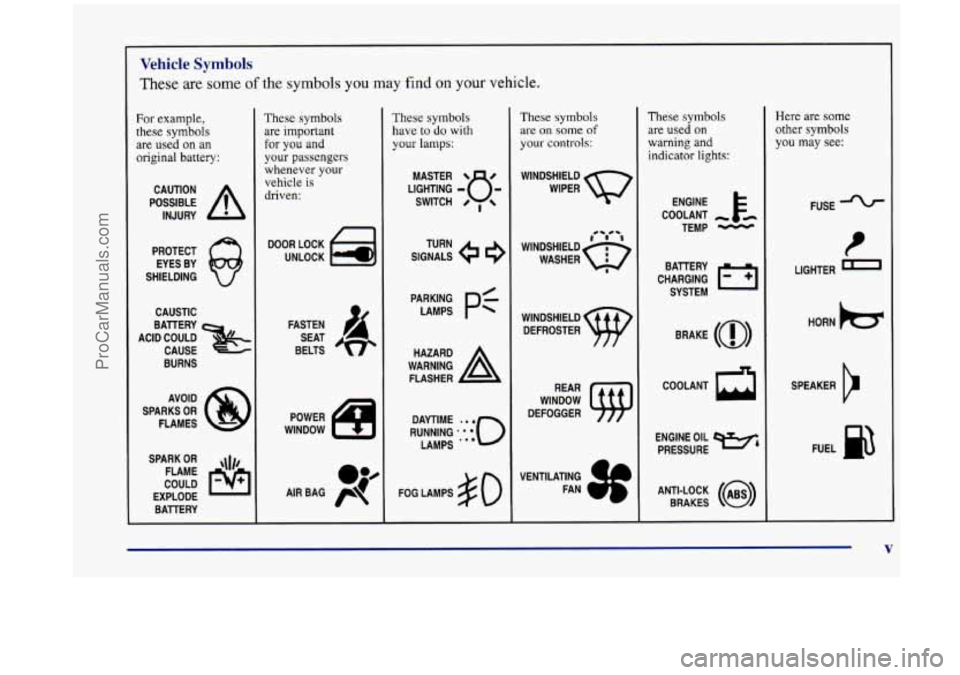
Vehicle Symbols
These are some of the symbols you may find on your vehicle.
For example,
these symbols are used on an
original battery:
POSSIBLE A
CAUTION
INJURY
PROTECT EYES BY
SHIELDING
CAUSTIC
ACID COULD BAllERY
CAUSE
BURNS
AVOID
SPARKS
OR
FLAMES
SPARK
OR ,\I/,
COULD FLAME
EXPLODE BAllERY
These symbols
are important
for you and
your passengers
whenever
your
vehicle is
driven:
DOOR LOCK
UNLOCK
FASTEN SEAT
BELTS
These symbols
have to do with
your lamps:
SIGNALS e
TURN
WARNING
A
HAZARD
FLASHER
FOG LAMPS
$0
These symbols
are on some of
your controls:
WINDSHIELD
WIPER
WINDSHIELD DEFROSTER
WINDOW
DEFOGGER
These symbols
are used on
warning and indicator lights:
ENGINE E*
COOLANT
TEMP
-
CHARGING I-1
BATTERY
SYSTEM
BRAKE
(a)
COOLANT a
ENGINE OIL e,
PRESSURE
ANTI-LOCK
(@)
BRAKES
Here are some other symbols you may see:
FUSE
LIGHTER
m
HORN )cr
SPEAKER
b
FUEL e3
ProCarManuals.com
Page 23 of 444
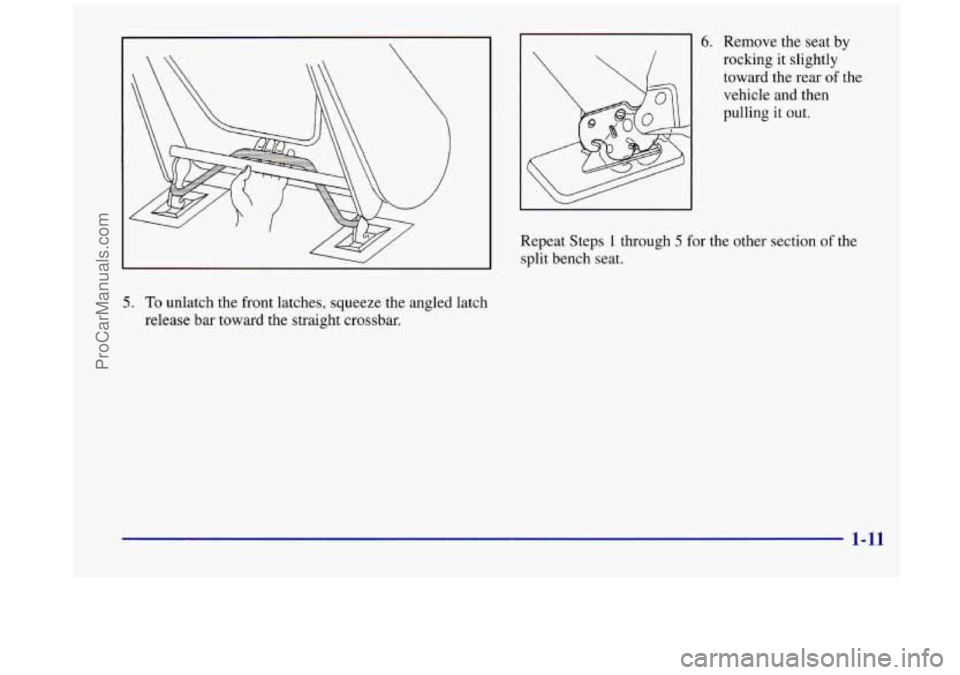
L
Repeat Steps 1 through 5 for the other section of the
split bench seat.
5. To unlatch the front latches, squeeze the angled latch
release bar toward the straight crossbar.
6. Remove the seat by
rocking it slightly
toward the rear
of the
vehicle and then
pulling it out.
1-11
ProCarManuals.com
Page 30 of 444
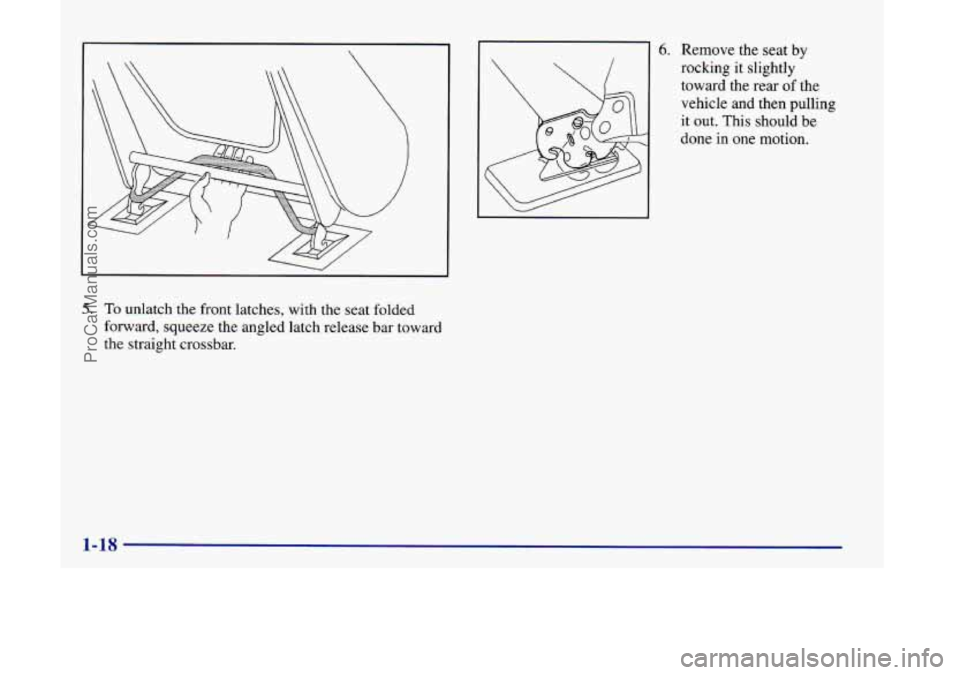
5. To unlatch the front latches, with the seat folded
forward, squeeze the angled latch release bar toward
the straight crossbar.
6. Remove the seat by
rocking it slightly
toward the rear
of the
vehicle and then pulling
it
out. This should be
done in one motion.
1-18
ProCarManuals.com
Page 37 of 444
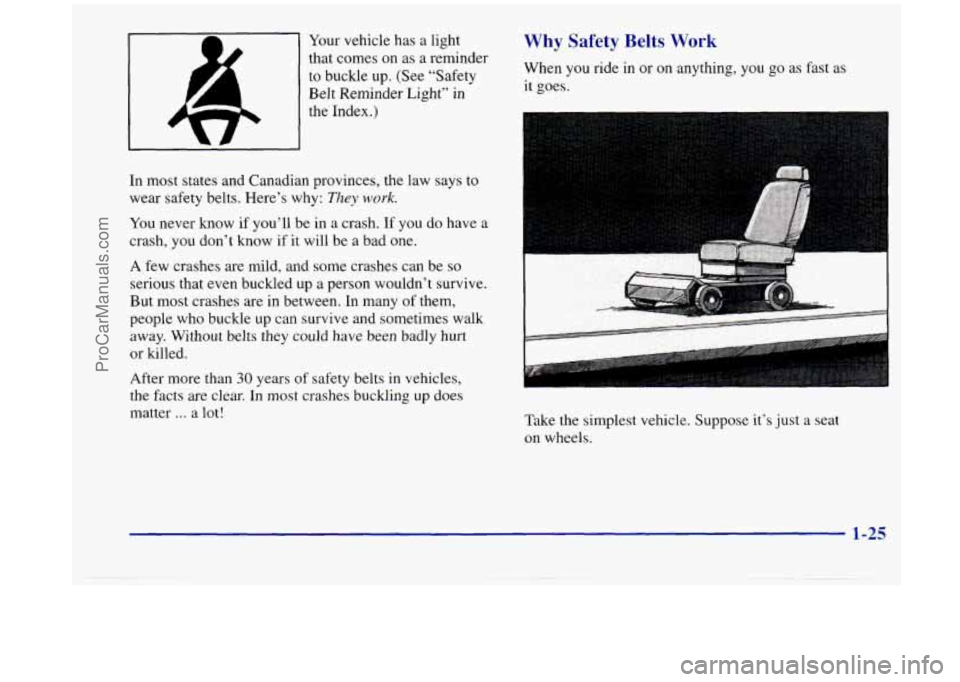
Your vehicle has a light
that comes on as a reminder
to buckle up. (See “Safety
Belt Reminder Light” in
the Index.)
In most states and Canadian provinces, the law says to
wear safety belts. Here’s why:
They work.
You never know if you’ll be in a crash. If you do have a
crash, you don’t know if it will be a bad one.
A few crashes are mild, and some crashes can be
so
serious that even buckled up a person wouldn’t survive.
But most crashes are in between. In many
of them,
people who buckle up can survive and sometimes walk
away. Without belts they could have been badly
hurt
or killed.
After more than
30 years of safety belts in vehicles,
the facts
are clear. In most crashes buckling up does
matter
. . . a lot!
Why Safety Belts Work
When you ride in or on anything, you go as fast as
it goes.
I
Take the simplest vehicle. Suppose it’s just a seat
on wheels.
1-25
ProCarManuals.com
Page 42 of 444

3. Pick up the latch plate and pull the belt across you.
Don’t let it get twisted.
The shoulder belt may lock
if you pull the belt across
you very quickly. If this happens, let the belt
go back
slightly to unlock it. Then pull the belt across you
more slowly.
4. Push the latch plate into the buckle until it clicks. Pull
up on the latch plate to make sure it is secure. If
the belt isn’t long enough, see “Safety Belt
Extender’’ at the end
of this section.
Make sure the release button on the buckle is
positioned so you would be able to unbuckle the
safety belt quickly if you ever had to.
5. To make the lap part tight, pull down on the buckle
end
of the belt as you pull up on the shoulder belt.
1-30
ProCarManuals.com
Page 52 of 444
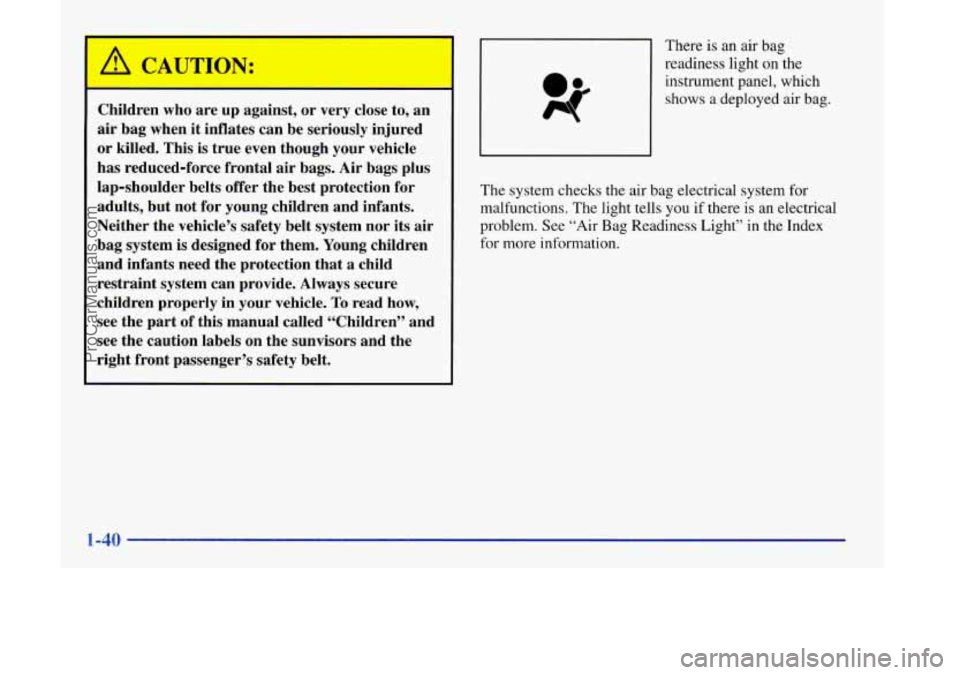
I
Children who are up against, or very close to, an
air bag when it inflates can be seriously injured
or killed. This is true even though your vehicle
has reduced-force frontal air bags. Air bags plus
lap-shoulder belts offer the best protection for adults, but not for young children and infants.
Neither the vehicle’s safety belt system nor its
air
bag system is designed for them. Young children
and infants need the protection that
a child
restraint system can provide.
Always secure
children properly in your vehicle.
To read how,
see the part of this manual called “Children” and
see the caution labels on the sunvisors and the
right front passenger’s safety belt. There
is an air bag
readiness light on the
instrument panel, which
shows a deployed air bag.
The system checks the air bag electrical system for
malfunctions. The light tells you if there is an electrical
problem. See “Air Bag Readiness Light” in the Index
for more information.
1-40
ProCarManuals.com
Page 60 of 444
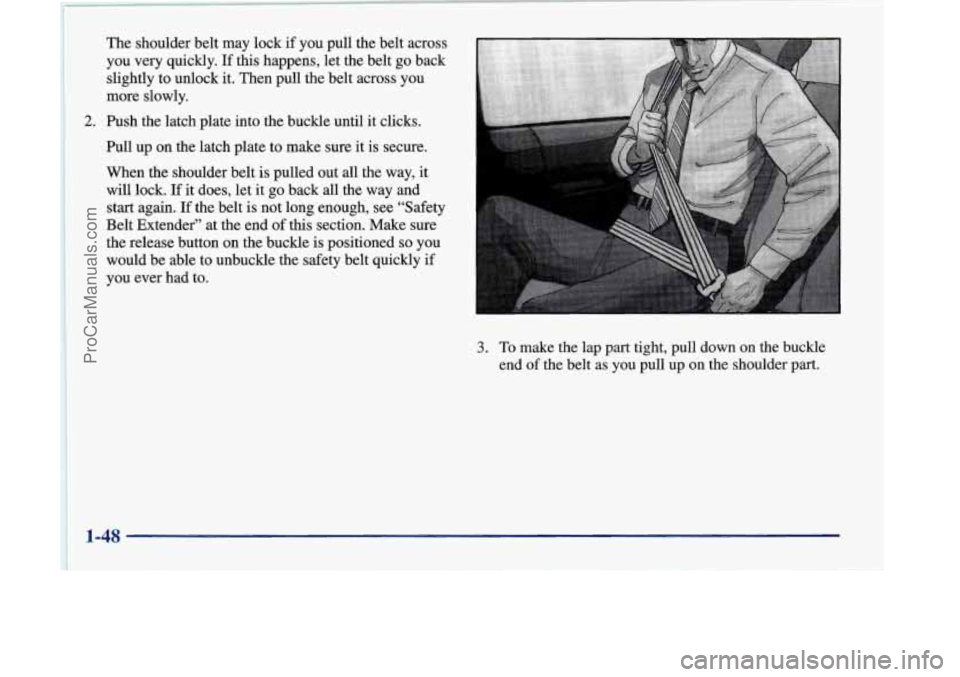
The shoulder belt may lock if you pull the belt across
you very quickly. If
this happens, let the belt go back
slightly to unlock it. Then pull the belt across you
more slowly.
2. Push the latch plate into the buckle until it clicks.
Pull up on the latch plate to make sure it
is secure.
When the shoulder belt is pulled out
all the way, it
will lock.
If it does, let it go back all the way and
start again.
If the belt is not long enough, see “Safety
Belt Extender” at the end
of this section. Make sure
the release button on the buckle is positioned
so you
would be able to unbuckle the safety belt quickly if
you ever had to.
3. To make the lap part tight, pull down on the buckle
end of the belt as you pull up on the shoulder part.
1-48
ProCarManuals.com
Page 88 of 444
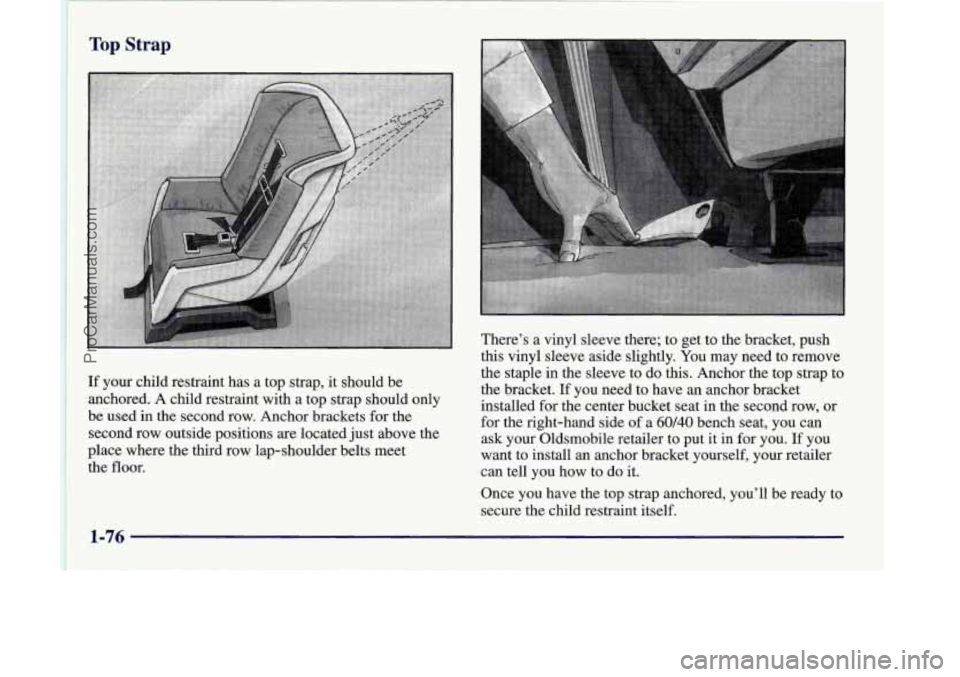
Top Strap
If your child restraint has a top strap, it should be
anchored. A child restraint with a top strap should only
be used in the second row. Anchor brackets for the
second row outside positions
are located just above the
place where the third row lap-shoulder belts meet
the floor. There's
a vinyl sleeve there; to get to the bracket, push
this vinyl sleeve aside slightly. You may need to remove
the staple in the sleeve to
do this. Anchor the top strap to
the bracket. If you need to have an anchor bracket
installed for the center bucket seat in the second row, or
for the right-hand side of a
60/40 bench seat, you can
ask
your Oldsmobile retailer to put it in for you. If you
want to install an anchor bracket yourself, your retailer
can tell you how to
do it.
Once you have the top strap anchored, you'll be ready to
secure the child restraint itself.
1-76
ProCarManuals.com
Page 101 of 444
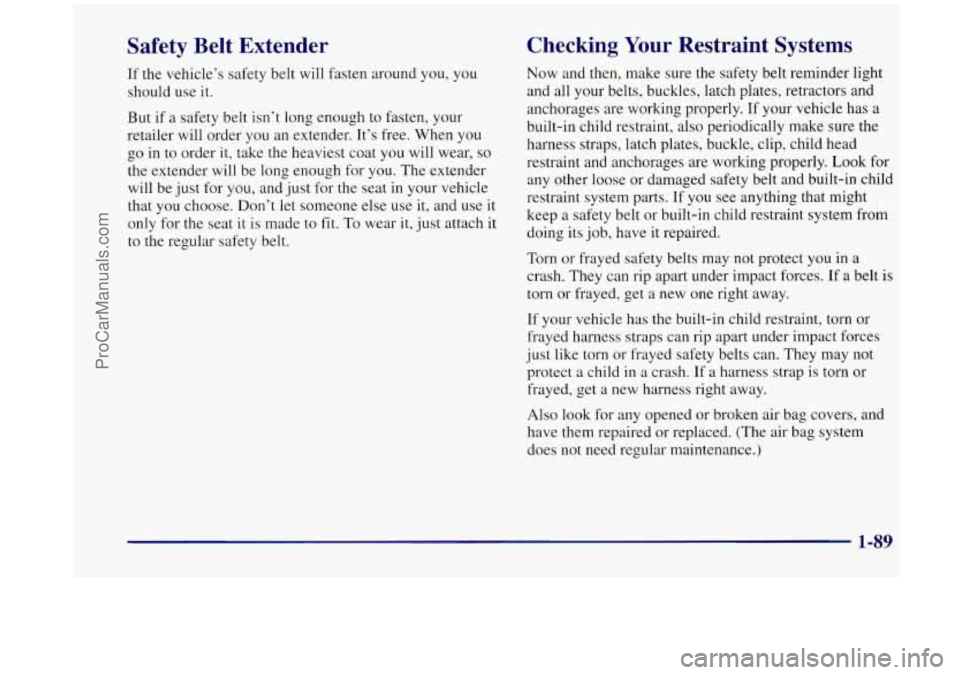
Safety Belt Extender
If the vehicle’s safety belt will fasten around you, you
should use it.
But if a safety belt isn’t long enough to fasten, your
retailer will order you an extender. It’s free. When you
go in to order it, take the heaviest coat you will wear, so
the extender will be long enough for you. The extender
will be just for you, and just for the seat in your vehicle
that you choose. Don’t let someone else use it, and
use it
only for the seat it is made to fit. To wear it, just attach
it
to the regular safety belt.
Checking Your Restraint Systems
Now and then, make sure the safety belt reminder light
and all your belts, buckles, latch plates, retractors and
anchorages are working properly. If your vehicle
has a
built-in child restraint, also periodically make sure the
harness straps, latch plates, buckle, clip, child head
restraint and anchorages are working properly.
Look for
any other loose or damaged safety belt and built-in child
restraint system parts. If you see anything that might
keep a safety belt or built-in child restraint system from
doing its job, have it repaired.
Torn or frayed safety belts may not protect you in
a
crash. They can rip apart under impact forces. If a belt is
torn or frayed, get a new one right away.
If your vehicle has the built-in child restraint, torn or
frayed harness straps can rip apart under impact forces
just like torn or frayed safety belts can. They may not
protect a child in a crash. If
a harness strap is torn or
frayed, get
a new harness right away.
Also look for any opened or broken air bag covers, and
have them repaired
or replaced. (The air bag system
does not need regular maintenance.)
1-89
ProCarManuals.com
Page 103 of 444
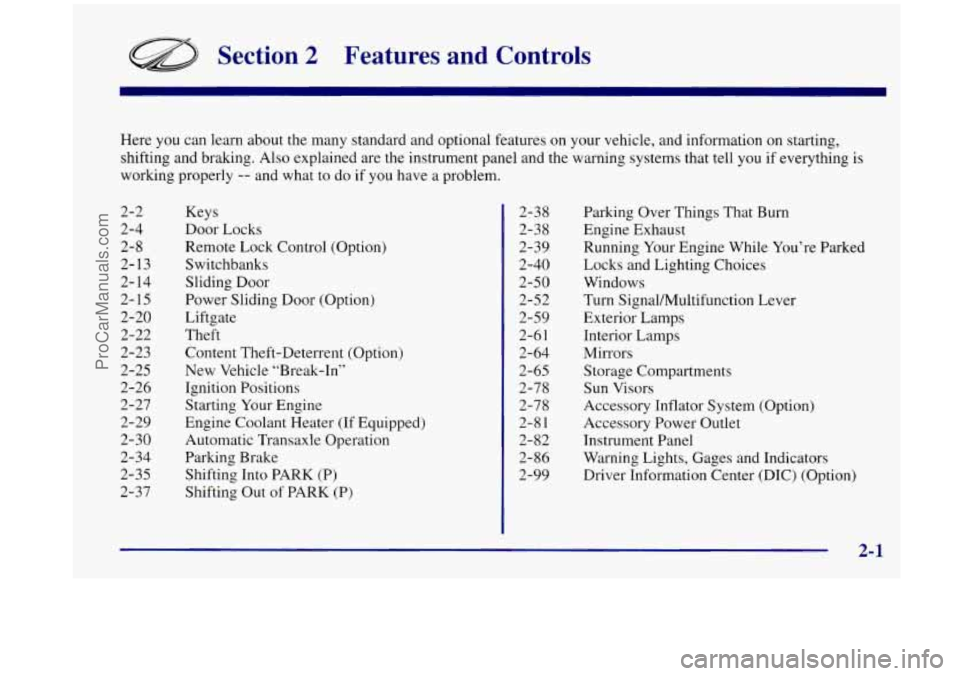
Section 2 Features and Controls
Here you can learn about the many standard and optional features on your vehicle, and information on starting,
shifting and braking. Also explained are the instrument panel and the warning systems that tell you if everything is
working properly
-- and what to do if you have a problem.
2-2
2-4
2-8
2-13
2-
14
2-15
2-20
2-22
2-23
2-25
2-26
2-27
2-29
2-30
2-34 2-35
2-37 Keys
Door Locks
Remote Lock Control (Option)
Switchbanks
Sliding Door
Power Sliding Door (Option)
Liftgate
Theft
Content Theft-Deterrent (Option)
New Vehicle “Break-In”
Ignition Positions
Starting Your Engine
Engine Coolant Heater
(If Equipped)
Automatic Transaxle Operation
Parking Brake
Shifting Into PARK
(P)
Shifting Out of PARK (P)
2-38
2-38
2-39
2-40
2-50
2-52
2-59
2-6
1
2-64
2-65
2-78
2-78
2-8
1
2-82
2-86 2-99 Parking Over Things
That Burn
Engine Exhaust
Running Your Engine While You’re Parked
Locks and Lighting Choices
Windows
Turn SignalMultifunction Lever
Exterior Lamps
Interior Lamps
Mirrors Storage Compartments
Sun Visors
Accessory Inflator System (Option)
Accessory Power Outlet
Instrument Panel
Warning Lights, Gages and Indicators
Driver Information Center (DIC) (Option)
2-1
ProCarManuals.com